
Hotline Miami 2: Wrong Number review
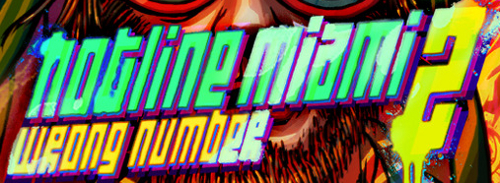
“‘Just a film’, huh? That’s one way to look at it.”
This review contains some very graphic images. Needless to say, anyone familiar with this series already knows what to expect. Parents, don’t let your children anywhere near these games or this review.
I am still convinced that, in this age of questioning the role of violent entertainment media in relation to real-world violence, no video game series asks the right questions but dearly beloved Hotline Miami.
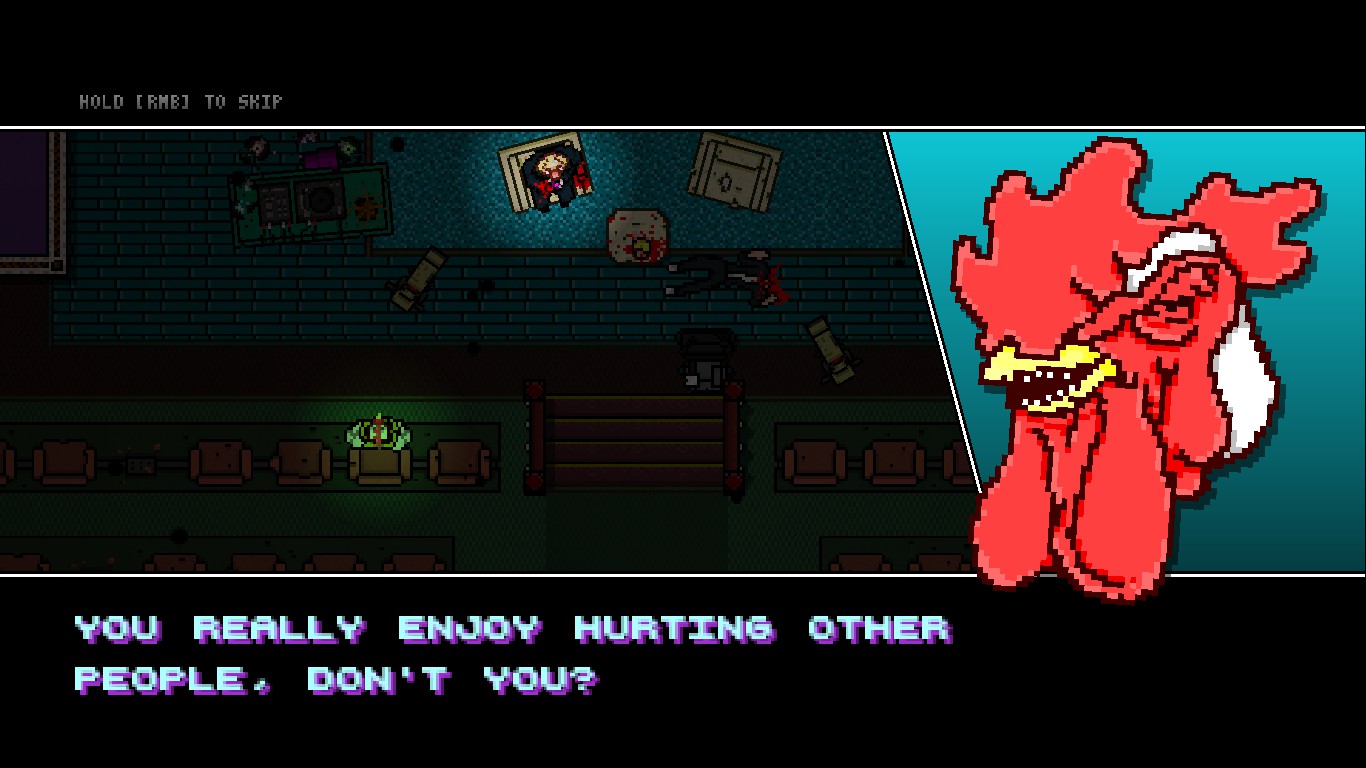
So goes the tagline for the 2012 top-down brawler released on PC and Playstation Network. A mysterious man in a chicken mask asks this of the main character, and by extension, of the player. Most people playing this game would reply, “No, I don’t like hurting other people.” Then why are you playing? Why are you still charging through apartments, night clubs, and police stations of 1980’s Miami, pummeling every vagrant to death and putting bullets through Russian mafia men? That’s the contradiction that the first Hotline Miami laid out before us. And now, Swedish developers Dennaton Games are out to give us the rest of the story.
Hotline Miami 2: Wrong Number deviates from its predecessor and forges a slightly new trail. The first time around, two men living in squalor received mysterious calls at home telling them to go to various addresses and murder everyone there. As the game progressed, the players met more and more difficult challenges, eventually uncovering the truth behind the phone calls. It was all very trippy and beautifully put together.
This new installment takes place before and after the first game, telling new stories about the consequences of Hotline Miami’s telephonic crime spree, the background to the shop keeper dude, and the perspective of the Russian mob. While the first game told a more linear story from two characters’ points of view, Hotline Miami 2 skips around to present the shattered, sorta intertwined stories of American military in Hawaii, Russian hitmen reclaiming territory, a journalist writing about Miami’s crime wave, a policeman trying to help his city, and a young man getting his hands dirty to help his ailing mother.
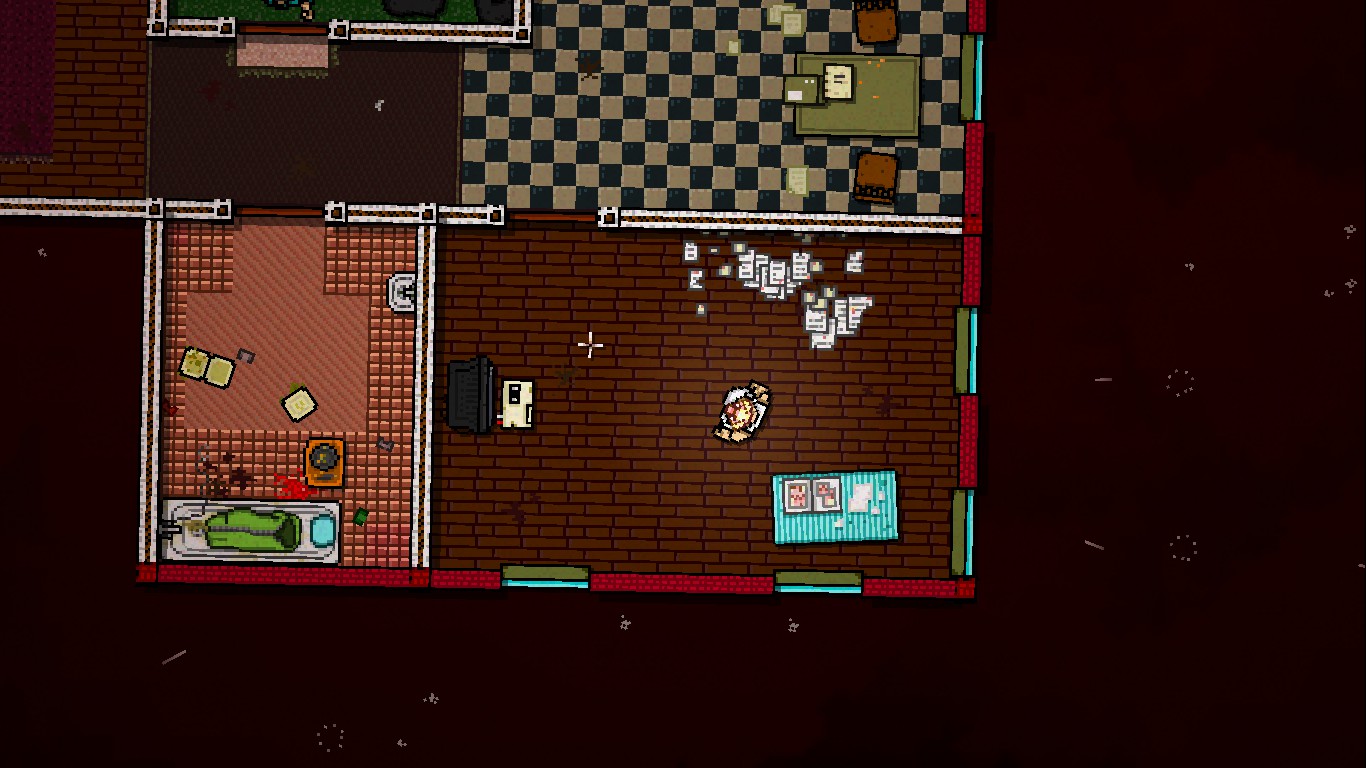
All the little details in the environment tell the story as much as the dialogue.
Within these scattered plot threads, the player is given control of a character with the implied purpose of killing every person in sight. In a given level, you may have four or five floors of enemies to sift through. Some of these may be American apartment complexes. Others yet may be Soviet military compounds, federal penitentiaries, tropical forests, or strip clubs. First, you must choose your fighting style. Different unlockable equipment will give you different abilities, such as a rolling dodge, instant melee kills, sniper rifles, flame throwers and whatnot.
In Hotline Miami 2, the story jumps around, so specific characters only have access to certain tools. Contrast this from Hotline Miami 1, where you always had access to all the masks. Eh, it makes sense for the story. There’s a lot more variation this time, too. Seriously, dual-wielding machine guns? A duo team with a chain saw and pistol? There’s even one guy who can clear stages without killing anyone. A lot more varied than Hotline Miami’s stat-changing masks. Plus, the floors themselves are designed around having certain aforementioned abilities.
These floors themselves contain separate rooms populated by melee weapon thugs (easy kills), gun-toting thugs (a little tougher as their range of sight is unpredictable), attack dogs (impervious to punches), giant thugs (only harmed by bullets), other giant thugs (only harmed by melee weapons), and ninja. There are also singular mini-bosses that aren’t so awkward as before. Don’t mind the AI for these guys as they glitch out and spin in place. I’m sure it’ll all get patched out.
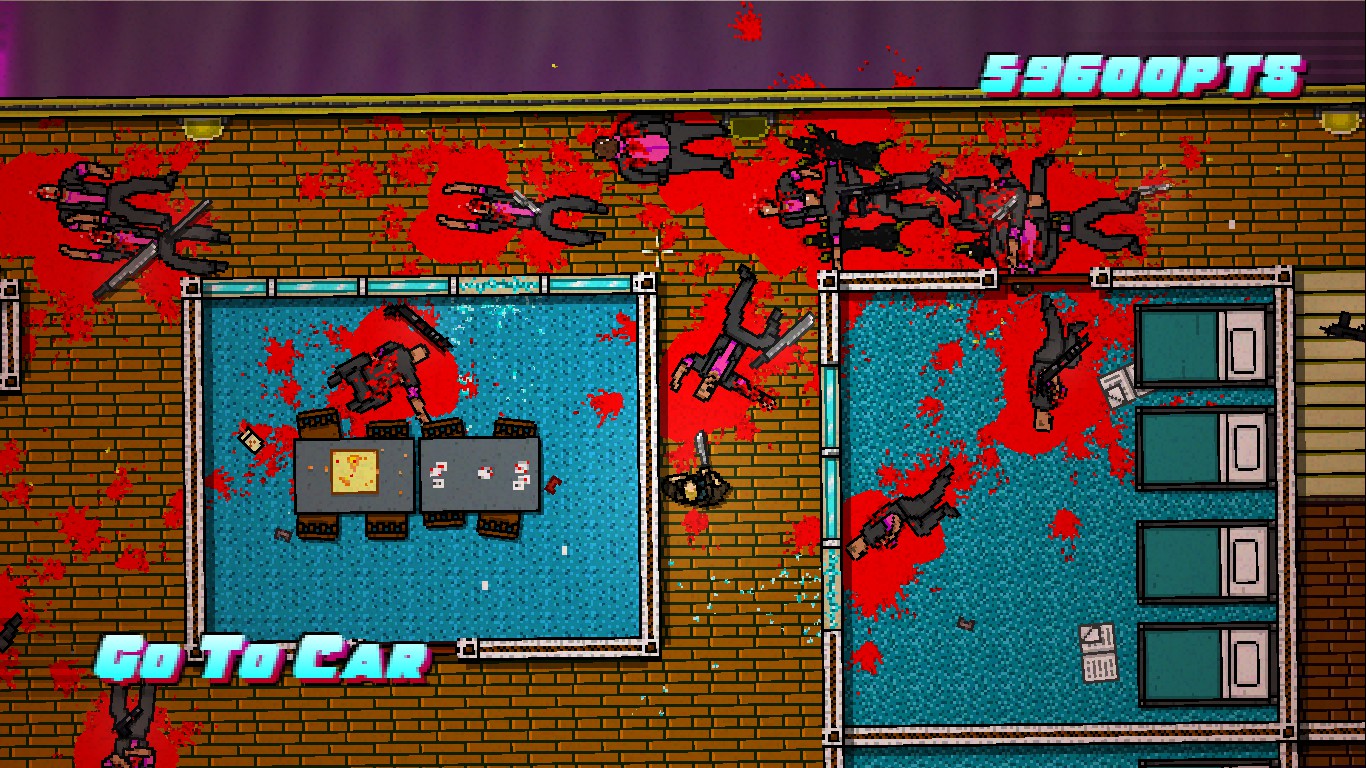
If you find this a little disturbing, that’s okay. That’s the point.
This sequel hosts not only a wider variety of stage designs, but also more variety in stage sizes. There’s a forested power plant level that’s expansive, never allowing the player to see the whole map at once. Bigger maps means that there could always be a rifleman peeking around a corner at any time, or a rabid canine popping out from a room that you thought was empty. Bigger maps create more challenge. It also makes for higher blood pressure.
Playing Hotline Miami 1 or 2 is like a blissful form of masochism. You will be killed. Over and over again. I unlocked the achievement for being killed one thousand times during my first playthrough. That’s how quickly this cycle of respawning and dying happens. It’s about learning a map’s nooks and crannies through reptition and failure. Frustrating is a word I’d never use to describe it, because every time a bouncer comes and punches your head open, you will always think of another path you could have taken, or how to lure that enemy out, or how far the gunmen can see through the transparent window barriers. Worse yet, enemies don’t always move and act the same way every time. Every life is a little unpredictable. You will die. You will try again. You will complete the level with enough mental training and determination. It may just take a few hundred tries.
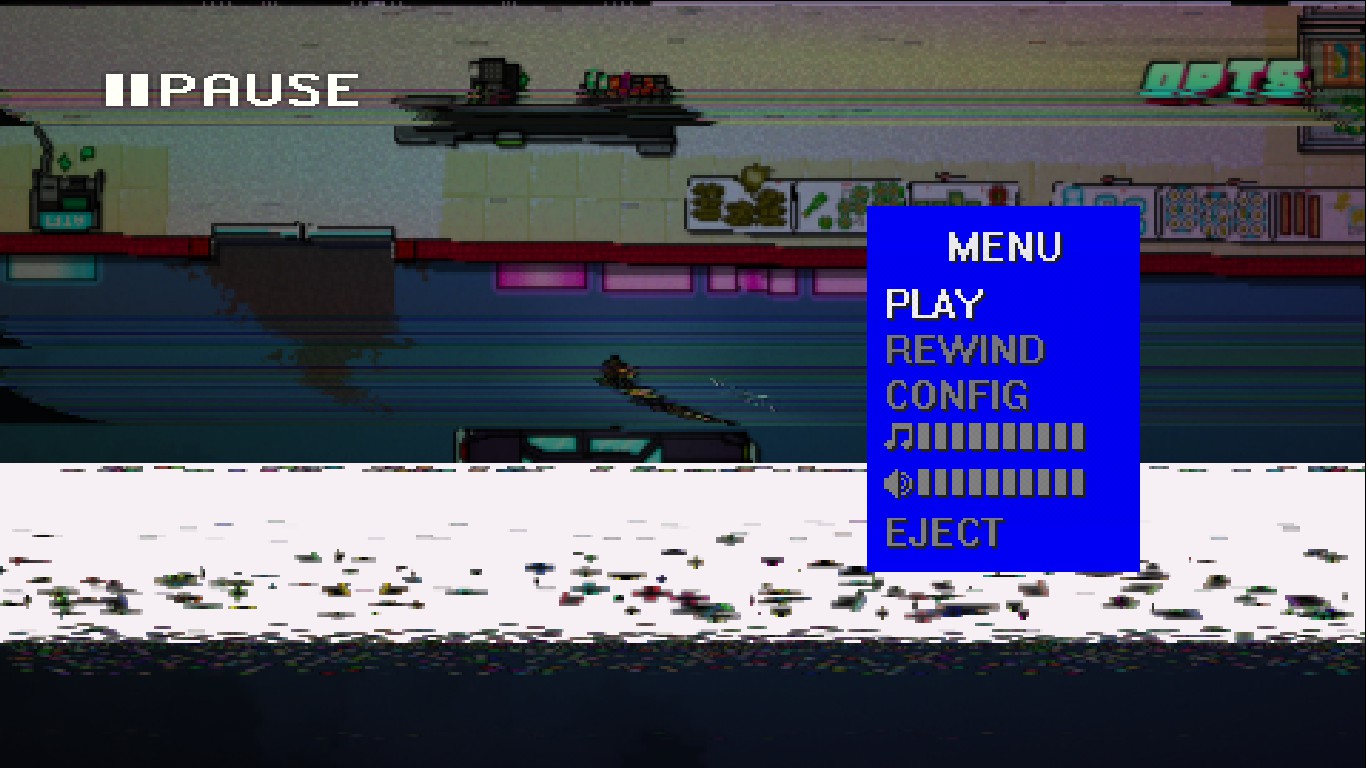
Possibly the greatest pause menu in history.
The one element here keeping this vicious cycle of self-destruction from turning stale is the game’s soundtrack. In fact, the soundtrack may be the best part about Hotline Miami 2. Featured artists fill the score with 80’s style synth tracks and a plethora of bass-pumping, speaker-blowing songs to perfectly accompany your on-screen mayhem.
Said mayhem, despite its intensity, never feels inundating or over-whelming. The visual design is colorful enough to help you distinguish the moving shapes of this retro pixelized world. The lack of realism makes those rolling heads and blood splattered floors seem a little less gut-wrenching. This doesn’t, however, prevent the story from having its more meaningful and touching moments told through text dialogue and character portraits. In fact, the individual tales all end on the best sour note possible. It’s all about chaotic lives being consumed by chaos.
You see, that depiction of violence is what I love so much about this series. The slaughter of polygons and sprites has been a part of this industry since its very beginning. In the Hotline Miami series, non-stop violence is being used to show us that violence begets more violence, destroying the lives of everyone in its path. What is brilliant here is that the game allows us to take control and see for ourselves the horrors that our animalistic nature can truly sow. When you complete a level, the placement of the exit forces the player to trace their steps back across the floors of dead bodies. It’s a powerful feeling. There was always a part of me that felt remorse for murdering all these non-existent lines of code so brutally. It wouldn’t be so effective reading it on a page or watching it in a theater. It’s a sort of experience that must be performed to be understood. The creators ask us questions about the existence of violence in our lives and in our entertainment. “Do you enjoy hurting other people?” And I think that’s genius.
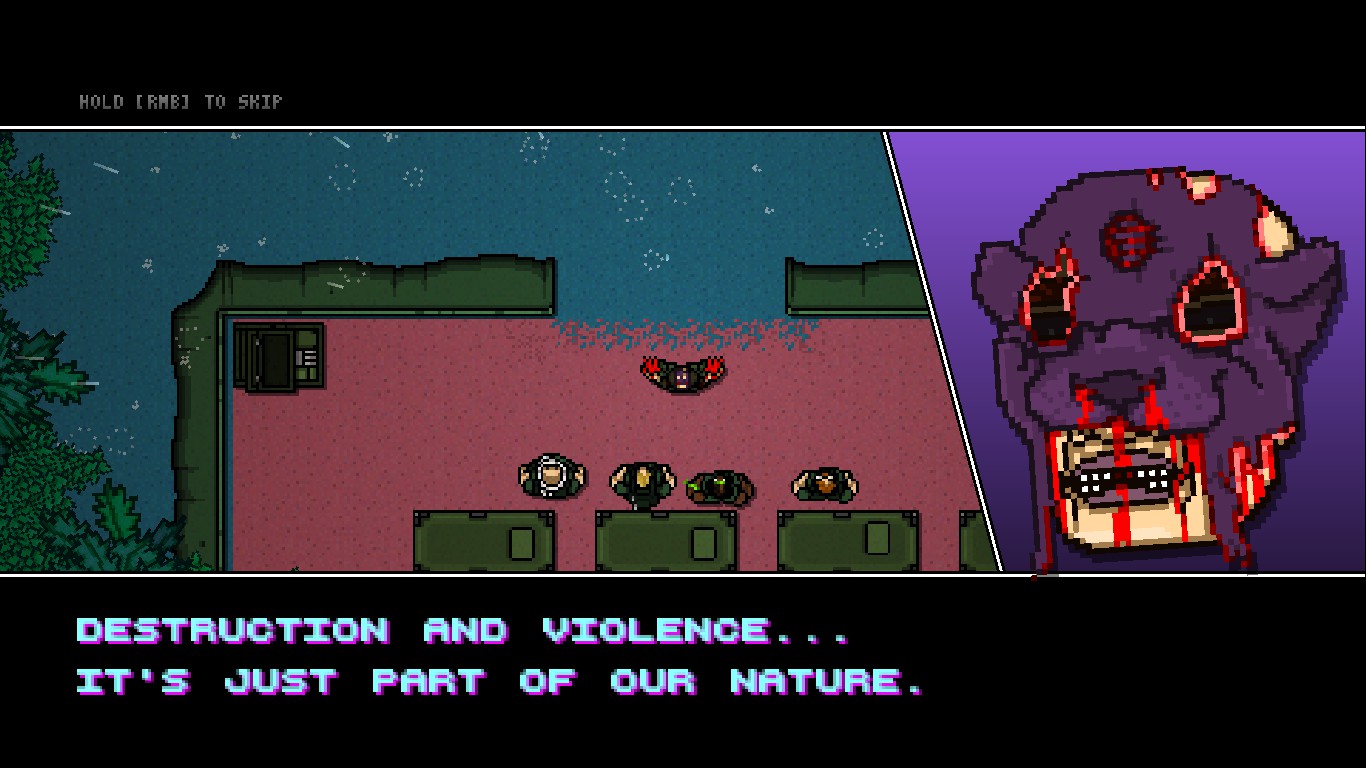
Hotline Miami 2: Wrong Number took me about nine hours to complete. There are still unlockable weapons for me to acquire and other secrets hidden in these sordid missions. That’s plenty of content for fifteen American dollars. Add to that a variety of weapons and fighting modes, more well-designed stages, an engaging story, and a phenomenal soundtrack. Hotline Miami 2 delivers on being a damn good game and a sequel that not only improves on the original but also takes it in a different direction. As it stands, there are places where this game could be tightened up, both in the dialogue dragging on and the AI acting wonky. All in all, Wrong Number is a totally unique action experience that starts up intense and feels like a rush of cocaine all the way through.
4/5
Damn Good
0 Comments
This post has been left all alone with no comments. Don't leave it lonesome - give it some company with a comment.